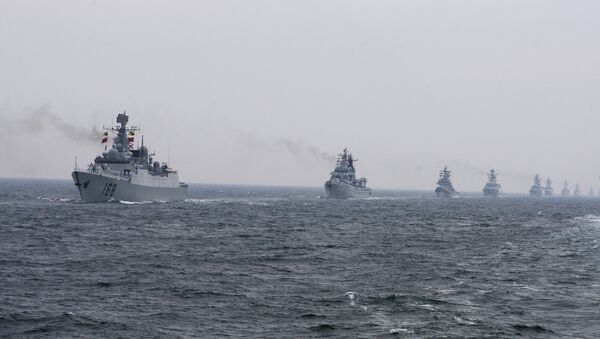New Delhi (Sputnik) — In a first of its kind, India recently conducted a massive exercise in the Indian Ocean involving its army, navy, air force and coast guards. The extensive exercise saw the participation of all operational ships, submarines and aircraft of the Indian Navy, along with men and equipment of the Indian Army, all types of aircraft of the Indian Air Force and ships and aircraft of the Indian Coast Guard. The Indian defense ministry claimed that the war games were aimed at threat perceptions of a two-front war, i.e. simultaneous combat with China and Pakistan.
READ MORE: Maldives Declines Indian Invite for Joint Exercise, Analysts Cite China as Cause
"The war games conducted on both the seaboards of India extended from the Northern Arabian Sea off the coast of Gujarat to the Southern Indian Ocean off the Sunda Straits near Indonesia," the defense ministry said about the exercise which concluded on 28 February.
Around the same time, Chinese news portal Sina.com.cn had reported that a fleet of destroyers, at least one frigate, a 30,000-tonne amphibious transport dock and three support tankers entered the Indian Ocean. Though the report did not mention any specific reason for the deployment, it was widely construed as an attempt by China to exert its influence over Maldives — the strategically located chain of islands in the Indian Ocean Region (IOR).
It was later reported that the Chinese warships turned around and returned to the South China Sea through the Lombok Strait. The four straits of Malacca, Sunda, Lombok and Ombai Wetar are used by China's People's Liberation Army (Navy) to cross between their bases in the South China Sea and the Indian Ocean.
"Mission-ready ships are now forward deployed in critical areas of the IOR with the inherent capability to respond to emerging threats and benign situations. The Navy has already reaped rich dividends from this concept," defense ministry exulted.
Indian Navy concludes two month Long War Game https://t.co/WDQOPXFqpX @DefenceMinIndia @nsitharaman @SpokespersonMoD @adgpi @IAF_MCC @HQ_IDS_India @PMOIndia @IndiaCoastGuard pic.twitter.com/SD9kRRmXOC
— SpokespersonNavy (@indiannavy) March 5, 2018
The Indian Navy adopted the "mission-based deployment" concept last year in July to maintain its dominance in the IOR. The exercise was mainly a review of his concept. The Indian Navy further revealed that it has "cut the flab" in the various exercises undertaken at sea.
"Greater focus has been accorded to conflict readiness across the spectrum, as well as realistic scenarios likely to be faced at sea," the defense ministry revealed.
It said that the focus has been on realistic scenarios likely to manifest in the future, including terrorist attacks from the sea on critical infrastructure and populated areas, defense of offshore oil resources of the country and protection of India's significant seaborne trade.





